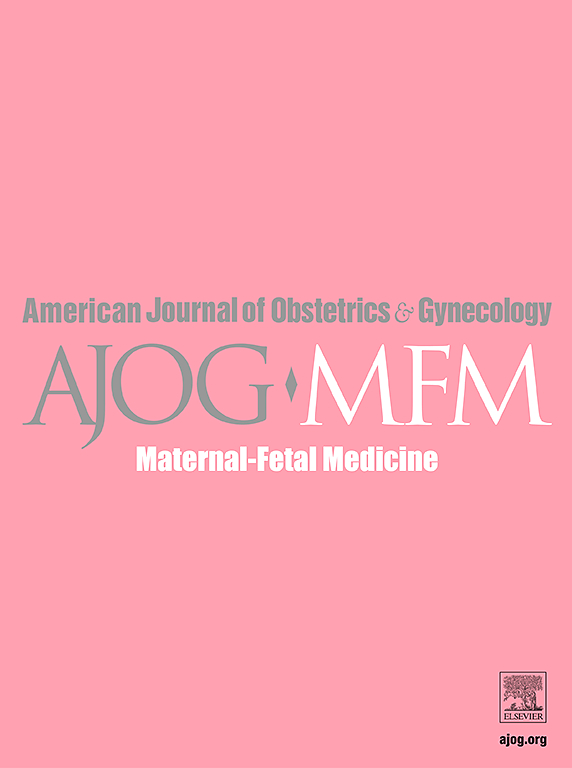伴有间歇脐动脉多普勒异常的I期双胎输血综合征:伴有间歇脐动脉多普勒异常的I期TTTS供体死亡。
IF 3.1
2区 医学
Q1 OBSTETRICS & GYNECOLOGY
American Journal of Obstetrics & Gynecology Mfm
Pub Date : 2025-08-15
DOI:10.1016/j.ajogmf.2025.101754
引用次数: 0
摘要
背景:双胎输血综合征(TTTS)是一种罕见的疾病,发生在约9%-15%的单绒毛膜双胎妊娠。建立了Quintero分期系统来对这种疾病的严重程度进行分类。已发表的选择性激光光凝交通血管(SLPCV)的结果表明,不同阶段TTTS的双重生存结果存在显著差异。根据Quintero分期,I期TTTS包括供体双脐动脉(UA)间歇性缺失或舒张末期速度逆转(AREDV)的患者,而持续供体双UA-AREDV的患者被归类为III期。间歇性UA-AREDV和持续性UA-AREDV之间的区别似乎自最初发表以来一直有不同的解释。目的:我们的目的是比较间歇性UA- aredv的I期患者与UA波形正常的I期患者的激光治疗结果;持续供体双UA-AREDV的III期患者用于比较。由于动脉动脉通信(AA)与术后供体死亡有关,因此还评估了三组内此类血管通信的发生率。研究设计:对三组接受激光手术治疗的TTTS单绒毛膜双羊膜双胞胎(2006-2023年)的供体双胞胎宫内胎儿死亡(IUFD)的主要结局进行分析:ⅰ期术前供体UA流量正常(ⅰ期正常);I期术前间断供体UA-AREDV (I期间断);III期术前持续供体UA-AREDV (III期)。结果:在349例研究患者中,101例为i期正常,36例为i期间歇,212例为iii期。供体IUFD发生率在I期正常组、I期间歇组和iii期组最低:3.0% vs 25.0% vs 29.2%。结论:间歇性UA-AREDV的TTTS I期患者在激光手术后供体IUFD的风险增加。本文章由计算机程序翻译,如有差异,请以英文原文为准。

Stage I twin-twin transfusion syndrome with intermittent umbilical artery Doppler abnormalities
Background
Twin-to-twin transfusion syndrome (TTTS) is a rare condition that occurs in approximately 9% to 15% of monochorionic diamniotic twin pregnancies. The Quintero staging system was established to categorize the severity of this disease. Published outcomes for selective laser photocoagulation of communicating vessels demonstrate a significant difference in dual survival outcomes among the different stages of TTTS. Per Quintero staging, Stage I TTTS includes those with donor twin umbilical artery (UA) intermittent, absent, or reversed end diastolic velocity (AREDV), whereas patients with persistent donor twin UA-AREDV are classified as Stage III. This distinction between intermittent and persistent UA-AREDV appears to have been variably interpreted since the original publication.
Objective
Our objective was to compare laser-treatment outcomes in Stage I patients with intermittent UA-AREDV vs Stage I patients with a normal UA waveform; Stage III patients with persistent donor twin UA-AREDV were used for comparison. Because arterio-arterial communications (AA) have been associated with postoperative donor demise, the rate of such vascular communications was also assessed within the 3 groups.
Study Design
Three groups of monochorionic diamniotic twins with TTTS that was treated with laser surgery (2006–2023) were analyzed for the primary outcome of donor twin intrauterine fetal demise (IUFD): Stage I with preoperative normal donor UA flow (Stage-I Normal); Stage I with preoperative intermittent donor UA-AREDV (Stage-I Intermittent); and Stage III with preoperative persistent donor UA-AREDV (Stage-III).
Results
Of 349 study patients, 101 were classified as Stage-I Normal, 36 were Stage-I Intermittent, and 212 were Stage-III. The rate of donor IUFD was lowest in Stage-I Normal vs Stage-I Intermittent and Stage-III groups: 3.0% vs 25.0% vs 29.2%, P<.0001. At least one survival did not differ among the 3 groups; dual survival was highest for Stage-1-Normal (97.0% vs 75.0% vs 66.0%, P<.0001) and differed from both Stage-I Intermittent and Stage-III groups in pairwise comparisons. AA communications were most common in the Stage-I Intermittent group: 27.7% vs 69.4% vs 42.5%, P<.0001. In a multiple logistic regression model, Stage-I Intermittent patients were 7 times more likely to have donor twin IUFD (Odds ratio [OR] 7.23 [1.69–30.82], P=.0075), as were Stage-III patients (OR 7.24 [2.06–25.47], P=.0020), compared to Stage-I Normal patients. In this same model, independently, patients with AA were 3.6 times more likely to have donor IUFD (OR 3.59 [1.95–6.61]; P<.0001).
Conclusion
TTTS Stage I patients with intermittent UA-AREDV were at increased risk of donor IUFD after laser surgery.
求助全文
通过发布文献求助,成功后即可免费获取论文全文。
去求助
来源期刊

American Journal of Obstetrics & Gynecology Mfm
Medicine-Medicine (all)
CiteScore
7.40
自引率
3.20%
发文量
254
审稿时长
40 days
期刊介绍:
The American Journal of Obstetrics and Gynecology (AJOG) is a highly esteemed publication with two companion titles. One of these is the American Journal of Obstetrics and Gynecology Maternal-Fetal Medicine (AJOG MFM), which is dedicated to the latest research in the field of maternal-fetal medicine, specifically concerning high-risk pregnancies. The journal encompasses a wide range of topics, including:
Maternal Complications: It addresses significant studies that have the potential to change clinical practice regarding complications faced by pregnant women.
Fetal Complications: The journal covers prenatal diagnosis, ultrasound, and genetic issues related to the fetus, providing insights into the management and care of fetal health.
Prenatal Care: It discusses the best practices in prenatal care to ensure the health and well-being of both the mother and the unborn child.
Intrapartum Care: It provides guidance on the care provided during the childbirth process, which is critical for the safety of both mother and baby.
Postpartum Issues: The journal also tackles issues that arise after childbirth, focusing on the postpartum period and its implications for maternal health. AJOG MFM serves as a reliable forum for peer-reviewed research, with a preference for randomized trials and meta-analyses. The goal is to equip researchers and clinicians with the most current information and evidence-based strategies to effectively manage high-risk pregnancies and to provide the best possible care for mothers and their unborn children.
 求助内容:
求助内容: 应助结果提醒方式:
应助结果提醒方式:


